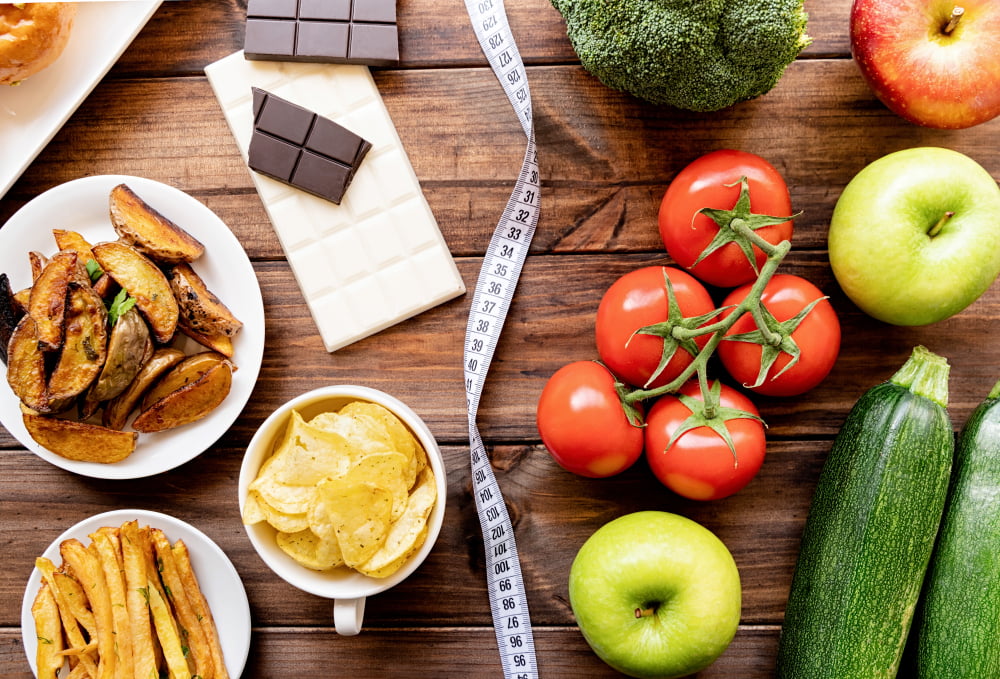Daily Calorie Intake Calculator

Are you looking to reach your weight goals?
Counting calories can be a great way to monitor your daily intake and help you achieve them.
The Daily Calorie Intake Calculator is an easy-to-use tool that can help you determine the right amount of calories for your body.
Get started today and use the calculator to reach your desired weight and live a healthier life.
Key Takeaways
- The Daily Calorie Intake Calculator estimates daily calorie consumption and provides guidelines for weight gain or loss.
- The calculator offers options for different units and age ranges, with gender options for male and female.
- There is a converter that can convert between Calories and other food energy units, such as nutritional calories, kilojoules, and joules.
- The article emphasizes that weight loss should be accompanied by proper diet and exercise, and suggests tracking calories and progress through apps or other methods.
Calorie Calculator
Using the Calorie Calculator, you can easily estimate your daily calorie intake to reach your weight goals. This calculator is designed to provide guidelines for weight gain or loss, and offers options for US, metric, and other units. It’s suitable for adults between the ages of 15 and 80, and the gender options include male and female.
Additionally, the Calorie Calculator includes a converter to quickly convert between Calories, nutritional calories, kilojoules, and joules. The conversion factor for nutritional calories is 4.1868. Links to BMI, body fat, and ideal weight calculators are also provided.
Knowing how many calories you should consume daily is an important part of successful weight loss, as it allows you to create a calorie deficit and reach your goals. For adults, the U.S. Department of Health recommends males consume 2,000-3,000 calories daily and females 1,600-2,400 calories. A 1,000 calorie daily deficit is a safe and achievable goal for weight loss.
Calorie counting also helps you to identify empty calorie foods and make healthier choices.
Equations for BMR
Knowing your basal metabolic rate (BMR) can help you calculate your daily calorie intake for weight loss. BMR is the energy expended while at rest and is used in equations to estimate daily calorie requirements. Three common equations for calculating BMR are the Harris-Benedict Equation, the Mifflin-St Jeor Equation, and the Katch-McArdle Formula.
| Equation | Description |
|---|---|
| Harris-Benedict | The original equation for calculating BMR, revised in 1984, and based on age, height, weight, and sex. |
| Mifflin-St Jeor | An updated version of the Harris-Benedict equation, more accurate, and based on age, height, weight, and sex. |
| Katch-McArdle | Based on lean body mass for resting daily energy expenditure (RDEE). More accurate for lean individuals who know their body fat percentage. |
Calculating BMR is only the first step in determining how many calories you need to achieve your weight loss goals. Weight loss should be accompanied by proper diet and exercise, and it’s important to find a strategy that fits within your lifestyle and can be adhered to. With this information, you can move on to the next section on weight loss and calorie counting.
Weight Loss and Counting
Counting calories is an effective approach to weight loss. It allows you to determine how many calories you should be consuming to reach your desired weight. A calorie calculator can be used to estimate daily calorie intake and provide guidelines for weight gain or loss. Depending on your age, gender, and activity level, your calorie needs will differ.
For adults, male or female, the U.S. Department of Health states that 2,000-3,000 calories per day is required to maintain weight, and 1,600-2,400 calories per day is required to lose weight.
When attempting to gain weight, the calculator can help you determine how many calories you should consume. To bulk, it’s recommended to increase your calorie intake by about 500-700 calories per day. To maintain a healthy balance, ensure you’re eating a nutritious mix of proteins, carbs, and fats. If you’re trying to lose weight, tracking your calories and progress through fitness apps is recommended.
Zigzag calorie cycling can be useful in preventing your body from reaching a weight loss plateau. It involves alternating the number of calories consumed on different days, allowing for flexibility in your diet and accommodating special occasions. However, weight loss should be accompanied by proper diet and exercise. Rapid weight loss can have negative health effects and depriving your body of essential nutrients can be detrimental to weight loss.
Calorie counting can help you become more aware of different types of foods and their calorie content. It also helps you understand how certain foods affect your feelings of satiety. To get the most out of calorie counting, use food labels, online nutritional databases, and measure protein, carbs, and fats for each meal. Consulting a healthcare professional or nutritionist can help you choose the right approach that fits within your lifestyle.
Considerations for Weight Loss
When it comes to successful weight loss, it’s important to pick a strategy that works for you and to make long-term adjustments. Calorie counting, combined with a healthy diet and exercise, can be an effective approach. Rapid weight loss (more than two pounds per week) can be dangerous, so it’s important to find the right balance of calories and nutrition.
The U.S Department of Health recommends adult males consume 2,000-3,000 calories per day to maintain weight, and adult females need around 1,600-2,400 calories. To gain weight, you’ll need to consume more calories than your body needs. A safe bet is to consume 250-500 extra calories per day, which should lead to around 0.45 kg of weight gain per week. If your goal is to build muscle, you’ll need to consume a bit more; a good rule of thumb is to consume a surplus of around 500-700 calories.
Use the calorie calculator to determine how many calories you need to consume to achieve your goals. Remember that high-calorie foods aren’t necessarily unhealthy, and cutting calories too drastically can lead to nutrient deficiencies. Eating a healthy diet with unprocessed foods and counting calories can help you reach your weight loss goals.
Benefits of Counting and Eating
By carrying on the discussion from the previous subtopic, counting calories and eating a healthy diet can provide a number of benefits when it comes to weight loss. Calorie counting increases awareness of different types of foods and their calorie content, helping individuals understand how certain foods affect their feelings of satiety. It also provides a quantifiable perspective on exercise and its role in counteracting calorie intake. For sustainable weight loss, the goal is to pick a strategy that fits within one’s lifestyle and can be adhered to. This allows for flexibility, such as accommodating special occasions or cheat days.
When it comes to how much calories should i eat to gain muscle, depending on age, gender, height, and activity level, adult males generally require 2,000-3,000 calories per day to maintain weight, and adult females need around 1,600-2,400. High-calorie foods are calorically dense, but not necessarily unhealthy. Low-calorie foods have fewer calories relative to serving size, and empty calories, such as those in added sugars and solid fats, contain few to no nutrients. Eating a healthy diet with unprocessed foods is correlated with being healthier and can result in sustainable weight loss.
To determine the right calorie intake for weight loss, consulting a healthcare professional or nutritionist can provide guidance in selecting the right approach. With this in mind, selecting the right goal and activity level is important for successful weight loss.
Selecting Goal and Activity Level
Once you’ve determined the right calorie intake for weight loss, it’s time to select the right goal and activity level. Rapid weight loss isn’t recommended, as it can have negative health effects. Instead, aim for a maximum daily calorie reduction of 1000 calories.
Tracking calorie intake and progress with apps or other methods is recommended for successful weight loss. Zigzag calorie cycling is another approach to counter the body’s adaptive tendencies and prevent a weight loss plateau. This involves alternating the number of calories consumed on different days, allowing for flexibility in the diet.
It’s important to pick a weight loss strategy that’s desirable and achievable. Consulting a healthcare professional or nutritionist can provide guidance in selecting the right approach. To maintain weight, determine the optimal balance of protein, fats, and carbohydrates through the Macronutrient Calculator.
Lastly, join a supportive fitness community to stay motivated and share progress.
Frequently Asked Questions
What Is the Maximum Calorie Reduction Recommended for Weight Loss?
It is generally advisable to aim for a maximum daily calorie reduction of 1000 calories when attempting weight loss. This method is slow and steady approach to reducing your calorie intake, and is often more successful than trying to cut too many calories too quickly.
Eating the right amount of calories is key to successful and sustainable weight loss, as depriving your body of essential nutrients can be detrimental to your health. Tracking your daily calorie intake and progress is also important to ensure that you’re on track with your goals.
What Are the Benefits of Zigzag Calorie Cycling?
Zigzag calorie cycling is a weight loss strategy that involves alternating the number of calories consumed on different days. By varying calorie intake, this technique can help prevent your body from adapting to a lower calorie intake and reaching a weight loss plateau.
It also provides flexibility in the diet, allowing for special occasions or cheat days. Additionally, zigzag calorie cycling can help you become more aware of different types of foods and their caloric content, and understand how certain foods affect your feelings of satiety.
How Is the Katch-Mcardle Formula Different From the Harris-Benedict Equation?
The Katch-McArdle Formula takes into account the lean body mass of an individual when calculating their resting daily energy expenditure (RDEE). This is different from the Harris-Benedict Equation which only considers age, gender, height, and weight.
The Mifflin-St Jeor Equation is more accurate than the Harris-Benedict Equation but the Katch-McArdle Formula is more accurate for lean individuals who know their body fat percentage.
It’s important to choose the right equation to achieve an accurate calculation of BMR.
How Should I Adjust Calorie Intake Based on Activity Level?
Your activity level affects your daily caloric needs. To maintain your current weight, you should stick to your estimated daily calorie needs.
If you want to lose weight, you should aim to reduce your calorie intake by up to 1000 calories per day.
On the other hand, if you’re trying to gain weight, you should increase your calorie intake. To do this, you may need to add a few healthy snacks or meals to your daily diet.
It’s important to find an approach that fits your lifestyle and is achievable. Consulting a healthcare professional or nutritionist can help you select the right approach.
What Are the Most Accurate Equations for Calculating Bmr?
The most accurate equations for calculating basal metabolic rate (BMR) are the Harris-Benedict Equation, the Mifflin-St Jeor Equation, and the Katch-McArdle Formula.
The Harris-Benedict Equation is the oldest and most widely used, but the Mifflin-St Jeor Equation is more accurate.
The Katch-McArdle Formula takes lean body mass into account for resting daily energy expenditure (RDEE). If you know your body fat percentage, the Katch-McArdle Formula is more accurate for you.
It’s important to choose an equation that’s right for you.
Conclusion
Counting calories can be a great way to help you reach your weight goals. With the Daily Calorie Intake Calculator, you can easily determine the right amount of calories for your body and get started achieving your goals.
By selecting your goal and activity level, you can customize the calculator to fit your needs. Whether you’re looking to gain weight or lose it, counting calories can help you get there.
So make sure to give the Daily Calorie Intake Calculator a try today and start living a healthier life.







